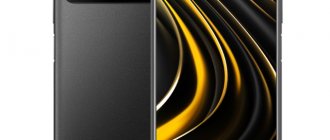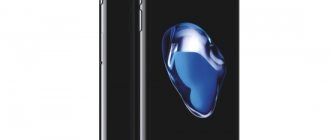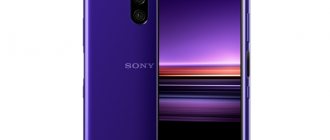| № | Name | Rating | Nomination |
| 1 | Apple iPhone 13 Pro 6/128GB | 4.75 | The brightest optics |
| 2 | Vivo V21 8GB/256GB | 4.73 | Optical stabilization of the front camera. Best front camera |
| 3 | Samsung Galaxy A22 4GB/128GB | 4.67 | Best price |
| 4 | Apple iPhone 12 4/128GB | 4.66 | The most popular. The lightest and most compact |
| 5 | OnePlus 9R 8GB/128GB | 4.59 | Optimal price-quality ratio |
| 6 | Google Pixel 5a 5G 6/128GB | 4.59 | Best Camera App |
| 7 | Xiaomi Mi 11 Ultra 12GB/256GB | 4.51 | Most Innovative |
| 8 | Sony Xperia 1 III 12GB/512GB | 4.50 | Large optical zoom |
| 9 | Samsung Galaxy S21 5G 8GB/256GB | 4.28 | |
| 10 | ASUS Zenfone 8 6GB/128GB | 4.25 |
Apple iPhone 11 64GB
The second generation of iPhone Xr, which is now called iPhone 11. What's new?
The design has changed, if at all, only slightly, but new shades of the body have appeared. The display is similar, its diagonal is 6.1 inches, it is created using IPS technology, and in the upper part there is the same large cutout for the camera and sensors.
The rear camera is new, dual – wide-angle and ultra-wide-angle modules. The processor is Apple A13 Bionic, one of the most powerful in the world of mobile technology. Supports fast and wireless charging, and has IP68 water protection.
- Screen diagonal: 6.1 inches
- Screen resolution: 1792×828
- Weight: 194 g
- Number of SIM cards: 2 (nano SIM + eSIM)
- Processor: Apple A13 Bionic
- Memory capacity: 64 GB
- RAM capacity: 4 GB
- Battery capacity: 3110 mAh
- Rear camera: dual 12/12 MP
- Front camera: 12 MP
- Memory card support: no
Apple iPhone Xr - photo 5+
Unlike the older model, there is no telephoto lens. The photo module received an enlarged sensor compared to its predecessor, but this did not significantly affect the quality of the images. The camera copes with noise. Hardware noise reduction works without problems.
The sensor handles complex object boundaries. Optical stabilization in iOS smartphones is not satisfactory.
Advantages:
- performance;
- long battery life;
- quality of shooting at night;
- sound of the main speaker;
- NFC;
- CPU
Flaws:
- weight;
- no 3D Touch;
- build quality (sometimes you can find dust under the camera glass).
Read more about Apple iPhone Xr ►
OnePlus 8 Pro 12/256GB
Flagship OnePlus with a huge reserve of power: thanks to the powerful Qualcomm Snapdragon 865 processor and 12 GB of RAM. It is not surprising that the smartphone is in the top AnTuTu Benchmark.
OnePlus 8 Pro received a 6.78-inch display with a refresh rate of 120 Hz, a main camera of 4 modules and support for night mode (takes excellent pictures), stereo speakers, a 4510 mAh battery and, finally, wireless charging and protection from water and dust (IP68).
But the price tag of the smartphone is at the level of many famous competitors.
- Screen diagonal: 6.578 inches
- Screen resolution: 3168×1440
- Weight: 199 g
- Number of SIM cards: 2
- Processor: Qualcomm Snapdragon 865
- Memory capacity: 256 GB
- RAM capacity: 12 GB
- Battery capacity: 4510 mAh
- Rear camera: four modules 48/48/8/5 MP
- Front camera: 16 MP
- Memory card support: no
Realme X3 SuperZoom
- Processor: 8-core Qualcomm Snapdragon 855 Plus, clock speed 2.96 GHz
- Screen: 6.6 inches, resolution 2400 x 1080
- Cameras (main / front): 64 + 8 + 8 + 2 megapixels / 32 + 8 megapixels
- Memory (RAM / built-in): 8 GB / 128 GB
- Battery capacity: 4200 mAh
Price: from 31,000 rub.
Realme produces not only fairly high-quality smartphones, but also very inexpensive ones. If you want to buy a flagship, but don't chase innovations, then the X3 SuperZoom on last year's top-end Snapdragon 855 chip may be suitable for you. The device is equipped with a large screen with a refresh rate of up to 120 Hz and a good brightness level. And also large amounts of RAM and ROM, which is important for user needs that have increased in 2020.
The main four-sensor camera with a good night mode, the ability to record 4K video, slow motion up to 240 FPS, optical zoom and fast autofocus is responsible for shooting. The dual front camera will also provide high quality when shooting with bokeh effect.
Advantages:
- Large IPS display with 401 ppi and Gorilla Glass 5.
- High performance.
- Powerful cameras with OIS.
- Battery with 30W fast charging.
- High-quality surround sound.
- USB Type-C connector.
- There is NFC.
- OS Android 10.
Flaws:
- There is no fingerprint scanner in the screen (on the rear panel).
- Overcharge.
Samsung Galaxy S20
The youngest version in the S20 line.
In many ways, the model is similar to the device of the previous generation, but certainly not in design: here it is made in the style familiar to the latest models of the company.
The screen diagonal is 6.2 inches, with the thinnest frames, and therefore the body width is only 69.1 mm. The chip is the top-end Samsung Exynos 990, the memory capacity is 8 GB of RAM and 128 GB of ROM. The battery capacity here reaches 4000 mAh, there is fast and wireless charging, protection from water and dust, and high-quality stereo speakers.
The main camera is equipped with 3 modules. Need I say that it shoots great in all modes?
- Dimensions (WxHxD): 69.1×151.7×7.9 mm
- Screen diagonal: 6.2 inches
- Screen resolution: 3200×1440
- Weight: 163 g
- Number of SIM cards: 2
- Processor: Samsung Exynos 990
- Memory capacity: 128 GB
- RAM capacity: 8 GB
- Battery capacity: 4000 mAh
- Rear camera: triple 12/12/64 MP
- Front camera: 10 MP
- Memory card support: yes
Apple iPhone 11 Pro Max 256GB
At the time of writing, this is the top-end smartphone from Apple.
Unlike the iPhone 11, the camera in this case is triple - a telephoto lens is added to the wide-angle and ultra-wide-angle modules. The trick is that in the iPhone 11 stabilization is announced only for the wide-angle sensor, but here it is for wide-angle and telephoto. It is also worth recalling the night mode, which takes several photos and “stitches” them into one shot - this allows you to get an image of much higher quality.
Other differences: a large 6.5-inch AMOLED screen, completely different body colors, and the availability of versions with a large amount of built-in memory. Everything else is the same: processor, water protection, fast and wireless charging, etc.
- Screen diagonal: 6.5 inches
- Screen resolution: 2688×1242
- Weight: 226 g
- Number of SIM cards: 2 (nano SIM + eSIM)
- Processor: Apple A13 Bionic
- Memory capacity: 256 GB
- RAM capacity: 4 GB
- Battery capacity: 3500 mAh
- Rear camera: triple 12/12/12 MP
- Front camera: 12 MP
- Memory card support: no
Honor 30 Pro+
Smartphone with optical zoom Honor 30 Pro+
The flagship of the previous conventional generation. And the manufacturer relied on the integration of new technologies into the P30 Pro+. Here you have the highest ISO value and image stabilization due to the 2-hinge structure of the module.
Additional features:
- 5x optical zoom (also works in widescreen mode);
- AIS system (laser autofocus);
- hybrid zoom up to x50 (by default, maintaining resolution - only up to x10).
The photo app also has a separate mode for shooting the starry sky (“astro shot”). The quality is inferior to newer flagships, but only when examining each image in detail.
Samsung Galaxy Note 10+ 12/256GB
Of course, the flagship smartphone from Samsung could not do with optical stabilization - it is available here. The camera itself consists of 4 modules (ultra-wide-angle, wide-angle, telephoto lens, 3D depth camera) and allows you to take very high quality photographs. It is noteworthy that this also applies to the front camera (it is single).
What else can be noted? Cool case design, a chic 6.8-inch AMOLED display, a stylus that hides inside the case, a very powerful platform based on the Samsung Exynos 9825 processor and as much as 12 GB of RAM, cool sound, a powerful 4300 mAh battery, support for fast and wireless charging , water protection.
Note the front camera, which is elegantly integrated into the display.
What is optical stabilization and why is it needed?
Optical stabilization in smartphones is a compensator that eliminates the angular movements of the photosensor, which allows you to get a stable picture without the need for an external axial stabilizer.
This option is relevant not only for portrait and landscape photography; it simplifies the use of the camera when working with shutter speed and zoom.
Huawei P30 Pro
The flagship from Huawei with a triple rear camera - optical stabilization is available for the main module. The other two modules are a wide-angle and a telephoto lens, as well as ToF. In general, this is one of the best camera phones in the world, it takes amazing pictures, and this applies to both photographs taken during daylight hours and at dusk or even at night.
The buyer also receives a chic design, an excellent 6.47-inch AMOLED matrix, a powerful self-produced HiSilicon Kirin 980 chip and 8 GB of RAM, a capacious 4200 mAh battery with fast and wireless charging, and IP68 water protection.
The fingerprint sensor, like most competitors, is located in the display.
- Screen diagonal: 6.47 inches
- Screen resolution: 2340×1080
- Weight: 192 g
- Number of SIM cards: 2
- Processor: HiSilicon Kirin 980
- Memory capacity: 256 GB
- RAM capacity: 8 GB
- Battery capacity: 4200 mAh
- Rear camera: triple 40/20/8 MP
- Front camera: 32 MP
- Memory card support: yes
Honor 20 Pro 8/256GB
Flagship Honor. Unlike the Honor 20 version, the firmware received digital and optical stabilization for the main rear camera module with a resolution of 48 MP. The camera itself consists of 4 modules. How does it shoot? Yes, it’s very cool - for its price category.
What other features does Honor 20 Pro have? Let's include a front camera “built-in” into the display, a stylish body design, an excellent 6.26-inch screen (IPS), a platform based on the HiSilicon Kirin 980 chipset and 8 GB of RAM.
Unusually, the fingerprint scanner is located in the side power button.
- Screen diagonal: 6.26 inches
- Screen resolution: 2340×1080
- Weight: 182 g
- Number of SIM cards: 2
- Processor: HiSilicon Kirin 980
- Memory capacity: 256 GB
- RAM capacity: 8 GB
- Battery capacity: 4000 mAh
- Rear camera: four modules 48/16/8/2 MP
- Front camera: 32 MP
- Memory card support: no
Xiaomi Mi 10
- Processor: 8-core Qualcomm Snapdragon 865, clock frequency 2.84 GHz
- Screen: 6.67 inches, resolution 2340 x 1080
- Cameras (main / front): 108 + 13 + 2 + 2 megapixels / 20 megapixels
- Memory (RAM / built-in): 8 GB / 128 GB
- Battery capacity: 4780 mAh
Price: from 40,000 rub.
The tenth anniversary generation of the Xiaomi Mi flagship turned out to be successful, incorporating all modern trends. The smartphone has high performance, built on a chipset that supports 5G networks. Also, the new product for 2021 is equipped with a cool display, a powerful battery and multifunctional cameras.
The main one has a high-resolution Samsung Bright S5KHMX sensor, as well as sensors for portrait, macro and ultra-wide-angle shooting. Users have access to 8K video recording, slow motion up to 960 FPS, laser autofocus and much more. A relatively inexpensive flagship smartphone with all the features inherent in the top segment.
Advantages:
- Large SuperAMOLED display with 388 ppi, 90 Hz and Gorilla Glass 5.
- Flagship performance.
- Powerful main camera with OIS.
- In-screen fingerprint scanner.
- Battery with 30W fast charging and 10W wireless charging.
- USB Type-C connector.
- There is NFC.
- OS Android 10.
- Reasonable price.
- None.
Apple iPhone SE (2020) 128GB
From now on, iPhone SE (2020) is the smallest flagship smartphone in the world; there is no other like it, including in terms of popularity (production of the iPhone 8, as far as we know, has been discontinued).
The previous iPhone SE had optical stabilization, and our hero also has it. In general, in essence, this is a deep modernization of the iPhone 8: the same body, the same dimensions, but with a powerful Apple A13 Bionic chipset, the latest version of iOS firmware, eSIM support and the absence of 3D Touch. The cameras, by the way, are the same on both devices.
And here's what's interesting: despite the significant increase in power, the iPhone SE (2020) costs about the same as the iPhone 8 at the end of its career.
- Screen diagonal: 4.7 inches
- Screen resolution: 1334×750
- Weight: 148 g
- Number of SIM cards: 1
- Processor: Apple A13 Bionic
- Memory capacity: 128 GB
- RAM capacity: 3 GB
- Battery capacity: 1700 mAh
- Rear camera: 12 MP
- Front camera: 7 MP
- Memory card support: no
Top 7. Xiaomi Mi 11 Ultra 12GB/256GB
Rating (2021): 4.51
21 reviews taken into account from resources: Otzovik, Yandex.Market
Most Innovative There is no more technologically advanced and advanced gadget in this ranking than this one. It has the most expensive and powerful hardware, the coolest optics and a high-quality screen.
- Characteristics
Average price: 81,250 rub.
- Country: China
- Main camera: 50 + 48 + 48 MP
- Camera features: 5x zoom, f/1.95, 1920 fps
- Front camera: 20 MP, without autofocus, f/2.2
- Battery: 5000 mAh
- Weight: 234 g
An expensive flagship that is difficult to beat: the manufacturer used the latest technologies and developments. The camera impresses not only with its numbers, but also with its actual performance. It has the largest number of megapixels in total, and this despite the fact that there are three modules, not four. Two sensors have optical stabilization, one of which is equipped with a telephoto lens. The camera also boasts a five-fold zoom without loss of photo quality. And the frame rate when shooting video can reach 1920 per second - such a record high number allows you to create professional Slowmo. In reviews, users admit that the device is heavy and large - not suitable for everyone.
Advantages and disadvantages
- High resolution photo
- High frame rate when shooting video
- 5x optical zoom
- Big
- Heavy
- High price
Samsung Galaxy Note 10 Lite 6/128GB
For the Samsung Galaxy Note 10 Lite, optical stabilization is declared in the main and TV modules.
What is this? This is a light version of the Galaxy Note 10, the main feature of which, of course, is the presence of a stylus - previously only the flagships of the Galaxy Note line were equipped with it.
Note 10 Lite is far from flagship specifications, although for the money it is very good: 6.7-inch AMOLED screen, powerful Samsung Exynos 9810 chip and 6 GB of RAM, 4500 mAh battery with fast charging support, a very decent main camera with three modules.
- Screen diagonal: 6.7 inches
- Screen resolution: 2400×1080
- Weight: 199 g
- Number of SIM cards: 2
- Processor: Samsung Exynos 9810
- Memory capacity: 128 GB
- RAM capacity: 6 GB
- Battery capacity: 4500 mAh
- Rear camera: triple 12/12/12
- Front camera: 32 MP
- Memory card support: yes
Nubia Red Magic 5G
- Processor: 8-core Qualcomm Snapdragon 865, clock frequency 2.84 GHz
- Screen: 6.65 inches, resolution 2340 x 1080
- Cameras (main / front): 64 + 8 + 2 megapixels / 8 megapixels
- Memory (RAM / built-in): 8 GB / 128 GB
- Battery capacity: 4500 mAh
Price: from 46,000 rub.
With this smartphone, any gamer will be able to play all modern games at maximum graphics settings. But what is especially interesting is that the device supports a screen refresh rate of up to 144 Hz. This makes the picture very smooth and thereby increases the player's reaction during dynamic scenes. In addition, the image has high brightness, contrast and vibrant colors.
There is a game mode activated by a separate button on the side. Powerful cooling will ensure game stability for a long time and prevent the phone from overheating. The battery corresponds to the gaming level of the device, having good capacity and super-fast charging function.
The main camera is not a feature of the model, but has all the capabilities of the top segment including optical stabilization, 480 FPS slow motion, 8K video recording and laser autofocus.
Advantages:
- Game mode and active cooling.
- Large AMOLED display with 388 ppi and Gorilla Glass.
- Top performance.
- Powerful main camera with OIS.
- In-screen fingerprint scanner.
- Battery with super-fast charging 55W.
- USB Type-C connector.
- There is NFC.
- OS Android 10.
Flaws:
- High price.
- Weak front camera.
Google Pixel 3a 64GB
One of the most inexpensive models from Google, but the camera is one of the best in its class, if not the best. And don’t look at the fact that it only has one module - the quality of the photos is at the level of some flagships.
This is a relatively compact smartphone with a 5.6-inch diagonal screen, which is powered by a Qualcomm Snapdragon 670 chip, memory capacity - 4 GB of RAM and 64 GB of main memory. Traditionally, there is no slot for a memory card, and there is only one SIM card.
A 3000 mAh battery with fast charging support is installed, there is an NFC module, and a fingerprint scanner.
- Screen diagonal: 5.6 inches
- Screen resolution: 2220×1080
- Weight: 147 g
- Number of SIM cards: 1
- Processor: Qualcomm Snapdragon 670
- Memory capacity: 64 GB
- RAM capacity: 4 GB
- Battery capacity: 3000 mAh
- Rear camera: 12.2 MP
- Front camera: 8 MP
- Memory card support: no
The best inexpensive smartphones with optical stabilization
In this category, the main criterion is price. However, even in this economical segment you can find equipment with excellent consumer characteristics.
Xiaomi Mi Play 4/64GB
The new product for 2021 takes an honorable first place based on the results of a comprehensive assessment of basic parameters:
- the iridescent design of the lid is a high-quality embodiment of fashion trends;
- a large but not too large screen (5.84”) is convenient for performing work operations;
- optical stabilization;
- solid RAM (4GB) coupled with an 8-core processor (2.3 MHz) provide the ability to run “heavy” applications;
- with a number of pixels of 432 per inch, individual elements are not visible even with a close, careful study of the picture.
Advantages:
- reasonable price;
- good screen;
- performance;
- high resolution – Full HD+ compliance;
- good technical equipment.
Flaws:
- plastic cover;
- weak front camera.
HUAWEI P30 lite
The lightweight version (Lite) does not indicate significant limitations. This device runs on the new Android 9.0 OS. A large screen (6.15”) with a resolution of 415 ppi provides comfortable conditions for communicating on social networks, watching videos and current news. The proprietary Kirin 710 combined processor (8 cores; 2.2 MHz) provides high speed when running modern games.
Advantages:
- price-quality ratio
- spectacular appearance (glass + metal);
- fast charging;
- miniature “drop” to accommodate a high-quality front camera (32MP);
- wide-angle lens with built-in depth sensor.
Flaws:
- not detected.
Meizu 15 4/64GB
Despite its first appearance on the market in 2021, this model is still deservedly popular. According to user reviews, this inexpensive smartphone with optical stabilization is completely suitable for high-quality photo and video shooting. The manufacturer's choice of Sony cameras (12 and 20 megapixels) is of certain importance. A fairly high data processing speed is ensured by the powerful Snapdragon 660 processor. The ceramic body ensures long-term preservation of a beautiful appearance during intensive use.
Advantages:
- high-quality optics from a well-known brand;
- fast battery charging mode;
- stereo speakers;
- “face recognition” option;
- reliable durable protective coating of the body.
Flaws:
- The diagonal size is rated by some users as insufficient (5.45”).
Sony Xperia XA2 Dual
The small screen diagonal (5.2”) moved this model to the last position in the ranking of budget camera phones. Reliable but not the newest, the Snapdragon 630 processor offers average performance by today's standards. However, the general technical equipment allows solving typical practical problems without problems. Separately, it should be noted the excellent matrix (23 megapixels). In combination with a high-quality optical path, it performs its functions perfectly. The impeccable appearance is highly appreciated by lovers of classic elegant design solutions.
Advantages:
- good equipment for shooting;
- high screen resolution (424 ppi);
- scratch-resistant glass;
- aluminium case;
- realistic color reproduction (photos, display).
Flaws:
- solid weight (171 g);
- compact screen.
OPPO Reno 2 8/256GB
The new generation of OPPO Reno, the main feature of which is the retractable front camera, and it is made in a very unusual way, as you can see in the image below.
The main module with a resolution of 48 MP received optical stabilization, and it is complemented by three more modules: a telephoto lens, a wide-angle lens and for portrait mode.
Reno 2 is powered by the latest Qualcomm Snapdragon 730G chipset, the memory capacity in this version is 8 GB of RAM and 256 GB of ROM. The battery capacity is 4000 mAh, there is fast charging. The display diagonal is 6.5 inches.
- Screen diagonal: 6.5 inches
- Screen resolution: 2400×1080
- Weight: 189 g
- Number of SIM cards: 2
- Processor: Qualcomm Snapdragon 730G
- Memory capacity: 256 GB
- RAM capacity: 8 GB
- Battery capacity: 4000 mAh
- Rear camera: four modules 48/8/13/2 MP
- Front camera: 16 MP
- Memory card support: yes
Samsung Galaxy S10 8/128GB
“Medium” version in the Galaxy S10 line. It has a 6.1-inch screen that extends slightly onto the side edges - the side frames go unnoticed. It is also worth noting that the device turned out to be quite compact.
The processor is a proprietary Samsung Exynos 9820, the memory capacity in this version is 8 GB of RAM and 128 GB of ROM. This is a powerful connection. The rear camera is triple and takes simply great pictures. The front camera is “built-in” into the screen.
Supports fast and wireless charging, and is protected from water.
- Screen diagonal: 6.1 inches
- Screen resolution: 3040×1440
- Weight: 157 g
- Number of SIM cards: 2
- Processor: Exynos 9820
- Memory capacity: 128 GB
- RAM capacity: 8 GB
- Battery capacity: 3400 mAh
- Rear camera: triple 16/12/12 MP
- Front camera: 10 MP
- Memory card support: yes











